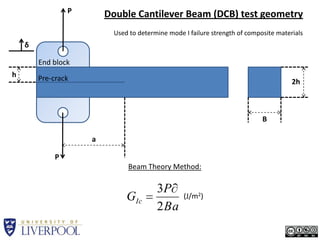Testing Techniques for Composite Materials
- 1. PDouble Cantilever Beam (DCB) test geometryUsed to determine mode I failure strength of composite materialsδEnd blockhPre-crack2hBaPBeam Theory Method:(J/m2)
- 2. End Notch Flexure (ENF) test geometryUsed to determine mode II failure strength of composite materialsaPBPre-crack2hLLBeam Theory Method:(J/m2)
- 3. Mixed-mode (I/II) Interlaminar Fracture test geometryUsed to determine mixed mode interlaminar failure strength of composite materialsBLaPδPre-crack2hMixed-mode fracture Energy:(J/m2)
- 4. Single Cantilever Beam (SCB) test geometryUsed to determine skin debonding energy for thick skinned composite sandwich structuresBClampPCore materialPre-crackClampaMixed-mode fracture Energy:(J/m2)
- 5. Centre Notch Flexure (CNF) test geometryUsed to determine skin debonding energy for thin skinned composite sandwich structuresBPPHoleδPre-crackaMixed-mode fracture Energy:(J/m2)
- 6. Interlaminar Shear Strength (ILSS) test geometryStandardised three point bend test used to determine interlaminate shear strength for composite structuresPB10mmδ2mm20mmInterlaminate Shear Strength:(J/m2)






